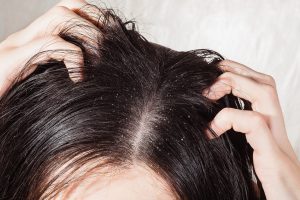A speck of white twinkled as it fell across the night sky, silent as it danced in the cold wind. She smiled in willful ignorance, praying what she had seen was impossible. Her head tilted, shoulders twitching in anxiety, hoping the one across from her had not noticed. Meanwhile, he felt the itch too, terrified as he glanced at the light fluff drifting onto the table before returning an anxious gaze. The winter was cold, snow was inevitable, but alas… no snow was forecasted for the next week. This is the tragedy of two consenting more than friends trying to figure it out, and their mutual but private battle with an affliction affecting 50 percent of all humans. This is dandruff.
What is Dandruff
Although these white flakes are most noticeable in your hair and on your clothes, dandruff isn’t really a hair condition but is actually due to your scalp. Naturally, your body produces skin cells constantly, and as they travel to the surface of the skin, the epidermis, the old cells fall off. For most, these cells are too small to be noticeable, but for others, when these cells clump together they can be rather large. These larger clumps of dead skin cells are commonly referred to as dandruff.
What Causes Dandruff
Dandruff affects about 50% of the population and the exact cause of it is actually unknown. Although, in recent studies, the yeast, Malassezia, is found to play a role in producing dandruff. When reducing the population of Malassezia in the scalp, amounts of flakes have been found to improve. But what is Malassezia and what does it do? Malassezia is a fungus that lives on the scalp where it, unfortunately, happens to be an ideal environment for it to survive. Here it releases enzymes that metabolize fat molecules, this produces oleic acids that are found to irritate the scalp. As a defense mechanism, your scalp can increase the rate it produces skin cells, sometimes causing a months worth of skin cells to appear on the surface in time frames as short as seven days.
Treatments for Dandruff
Many shampoos advertise being good treatments for dandruff but the ideal shampoo should contain anti-fungal or anti-yeast ingredients. A few common examples, found in Selsun and many other anti-dandruff shampoos, are zinc pyrithione and selenium sulfide which have the property of slowing down the growth of yeasts. When used in shampoo’s these ingredients are found to aid in reducing the increased production of skin cells by slowing down the metabolism of Malassezia for people that are dandruff-prone.
The video, “Dandruff | How To Get Rid Of Dandruff (2018)” by AbrahamThePharmacist, below basically sums up everything I’ve gone over with the exception of stating that Malassezia is the main cause of shampoo as literature states that there is limited research stating such.
Conclusion
Although we don’t have either confident cause or a concrete solution to dandruff, in using shampoos with anti-fungal ingredients this embarrassing condition can be minimized.
-Nelson Bulaun

